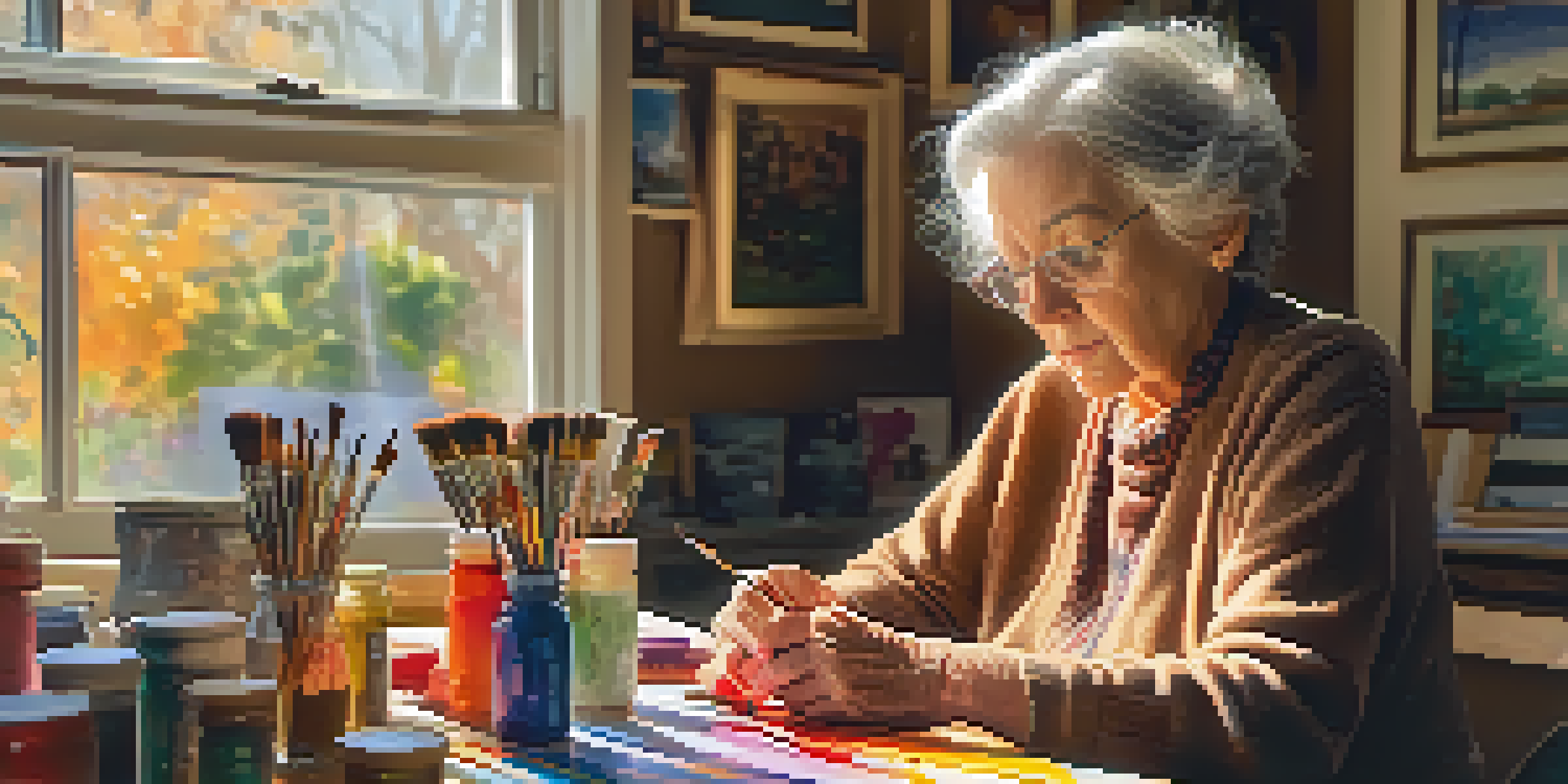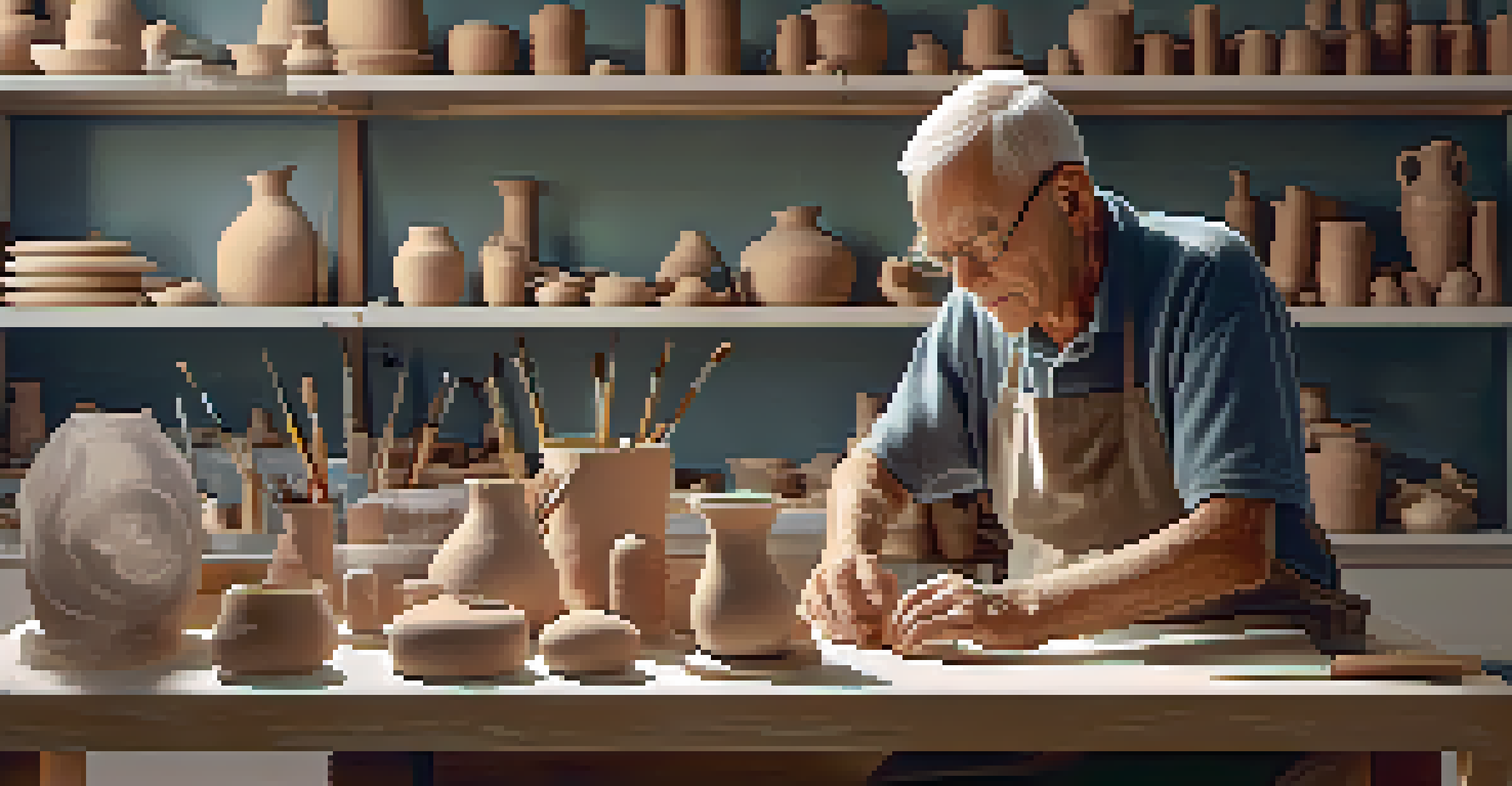The Therapeutic Benefits of Art for Older Adults

Art as a Tool for Emotional Expression in Seniors
As we age, finding ways to express our feelings can become more challenging. Art provides a unique outlet for older adults to communicate emotions that may be difficult to verbalize. Whether it's through painting, drawing, or crafting, creative activities can help seniors articulate their experiences and feelings.
Art enables us to find ourselves and lose ourselves at the same time.
Engaging in artistic endeavors can also foster a sense of accomplishment, which is vital for emotional well-being. Completing a piece of art, no matter how small, can boost self-esteem and provide a sense of purpose. This emotional expression not only enhances individual well-being but also promotes connections with others.
Moreover, sharing their artwork can create opportunities for social interaction, further alleviating feelings of loneliness. When seniors showcase their creations, they can engage in conversations, share stories, and bond over shared experiences, enhancing their emotional health.
Cognitive Benefits of Art Engagement for Older Adults
Art activities can significantly stimulate cognitive functions in older adults. Engaging in creative tasks requires critical thinking, planning, and problem-solving, all of which can help keep the mind sharp. For instance, choosing colors or planning a composition involves decision-making skills that are essential for cognitive health.

Studies have shown that seniors who regularly participate in art programs exhibit improved memory and cognitive flexibility. These activities can also slow down cognitive decline by encouraging brain activity and mental agility. It’s like giving the brain a workout, helping to maintain mental fitness as we age.
Art Enhances Emotional Expression
Art provides seniors with a unique outlet to communicate complex emotions, fostering connections and alleviating feelings of loneliness.
Additionally, the process of creating art can lead to moments of mindfulness, providing a break from everyday worries. This meditative state can enhance focus and clarity, further contributing to cognitive well-being. In essence, art serves as both a creative outlet and a brain booster.
Physical Benefits of Art Activities for Seniors
While art is often seen as a mental or emotional exercise, it can also provide physical benefits for older adults. Many art activities require fine motor skills, which can help improve dexterity and hand-eye coordination. Simple tasks like painting or sculpting can enhance physical abilities that might otherwise decline with age.
Every artist dips his brush in his own soul, and paints his own nature into his pictures.
Moreover, participating in group art classes often involves standing, stretching, and moving around, contributing to overall physical activity. This gentle movement is beneficial for maintaining mobility and flexibility, key factors in preventing falls and injuries among seniors.
Incorporating art into daily routines can also encourage older adults to engage more actively in their surroundings. The process of gathering materials or setting up spaces for art projects can promote physical engagement, making art a holistic activity that nurtures both mind and body.
The Role of Art in Social Connection for Older Adults
Art has a unique ability to bring people together, and this is particularly valuable for older adults who may face isolation. Community art classes, workshops, or group projects provide opportunities for seniors to connect with others, share experiences, and form friendships. These social interactions can significantly improve their overall mood and sense of belonging.
Additionally, collaborative art projects can foster teamwork and cooperation, enhancing social skills. When older adults work together on a piece, they learn to communicate, negotiate, and support each other, all of which are essential for building strong relationships.
Art Boosts Cognitive Health
Engaging in artistic activities stimulates cognitive functions, helping older adults maintain mental agility and memory.
The act of creating art in a group setting can also reduce feelings of loneliness. When seniors participate in communal art activities, they not only enjoy the creative process but also share laughter, stories, and connections, creating a supportive community that nurtures emotional health.
Art as a Means of Coping with Life Transitions
Life transitions, such as retirement, loss of loved ones, or moving to a new living situation, can be challenging for older adults. Art can serve as a powerful coping mechanism during these times of change. It allows individuals to process their feelings and experiences creatively, providing an emotional outlet for complex thoughts.
Creating art can also be a form of reflection, helping seniors to make sense of their past and present. By expressing their thoughts through different mediums, they can gain clarity and insight into their emotions, which can be particularly beneficial during difficult transitions.
Furthermore, art can inspire hope and resilience. By engaging in creative activities, seniors can envision new possibilities and future endeavors, turning the page on their life stories with optimism. This transformative power of art can significantly ease the burden of life’s changes.
Art Therapy: Professional Support for Seniors
Art therapy is a structured form of therapy that uses artistic methods to improve mental health and emotional well-being. For older adults, this can be a profound way to address specific issues such as depression, anxiety, or grief. Certified art therapists guide seniors through creative processes that promote healing and self-discovery.
During art therapy sessions, older adults can safely explore their emotions in a supportive environment. The therapist facilitates discussions around the artwork, allowing individuals to delve deeper into their feelings and experiences. This guided exploration can lead to significant breakthroughs and insights.
Art Fosters Social Connections
Participating in community art programs allows seniors to form friendships and reduce isolation through shared creative experiences.
Moreover, art therapy can be tailored to meet the unique needs of each individual. Whether focusing on memory recall, emotional support, or coping strategies, it provides a personalized approach to mental health, making art a vital component of holistic care for seniors.
The Lasting Impact of Art on Aging Well
The benefits of art for older adults extend far beyond immediate enjoyment; they contribute to aging well. Engaging in art promotes a positive outlook on life, encourages social engagement, and enhances cognitive and physical health. These factors collectively lead to a higher quality of life for seniors.
Moreover, integrating art into the lives of older adults can create a fulfilling routine that nurtures creativity and self-exploration. As they discover new talents and interests, seniors can develop a renewed sense of purpose, making each day more meaningful.

Ultimately, the lasting impact of art lies in its ability to enrich the lives of older adults. By embracing creativity, seniors can foster resilience, connection, and joy, demonstrating that it’s never too late to explore the transformative power of art.